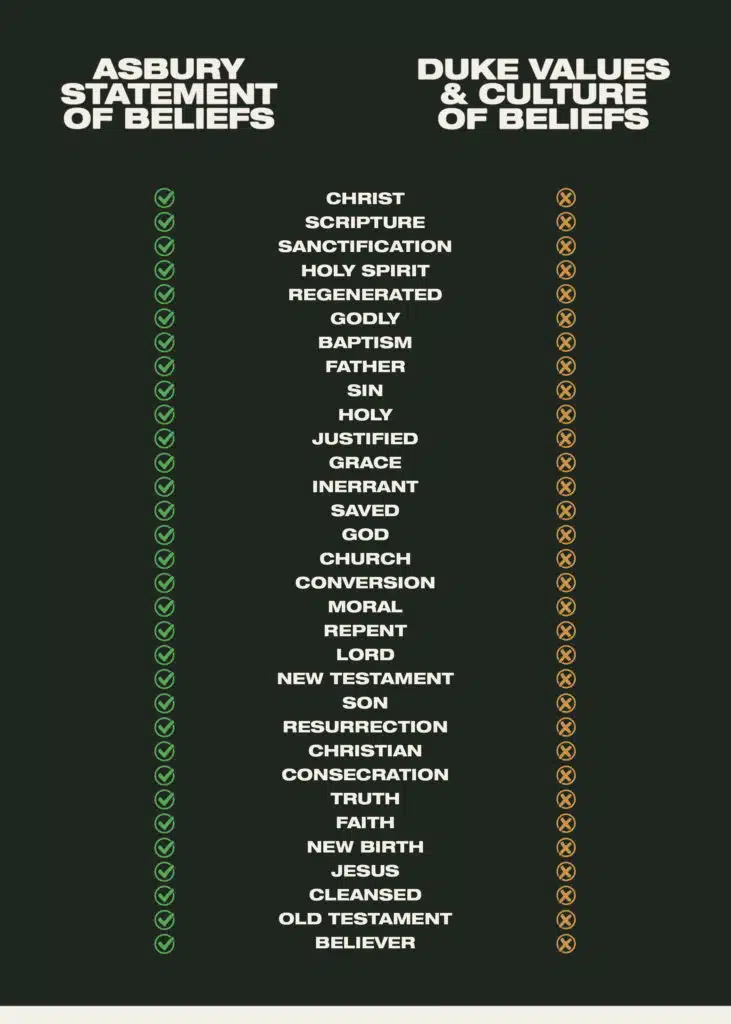The Asbury awakening vs. Dukes spiritual demise
George Shamblin2023-02-22T20:49:21+00:00
Inerrancy’s Role in Revival
On Wednesday, February 8, toward the end of a chapel meeting at Asbury University, a group of students stuck around to continue in prayer together. The prayer and worship haven’t stopped since and have drawn attention from around the country, with some calling it revival.
Is this the beginning of another awakening? It certainly could be—only time will truly tell. But there is one clear explanation for what’s happening in Kentucky, and at the heart of it is the word “inerrancy,” a big theological concept that’s the basis for our entire belief system. We’ll dig into it shortly.
In its simplest definition, revival makes someone feel alive again. In a spiritual revival, someone who’s alive but has fallen into a state of cold or spiritual death is brought to life by faith through the power of God. It’s a resurgence of interest in the ways of Christ.
All revivals share specific markers. The most important is and will always be the primacy of God’s Word—the belief that Scripture is alive, without error, free of fault, and 100% trustworthy (that the Bible is inerrant). Seriously, research anything from the First or Second Great Awakening to see for yourself. (The second marker is conviction over sin)
But how does this theological concept of “inerrancy” fit into revival and what’s happened at Asbury since February 8? A quick visit to Asbury’s website reveals their Statement of Beliefs, with number one being:
It’s there for all to see—Asbury holds the truth of Scripture in the highest regard. They believe in and teach the inerrancy of the Bible, the central marker needed for genuine revival.
I can’t help but compare what’s going on at Asbury with another well-regarded institution in Duke University. Both are known as private Methodist universities—so why do the current atmospheres at Asbury and Duke appear to be wildly divergent? On the one hand, there are early hints of revival emanating from Asbury and making national headlines. The round-the-clock prayer and worship appear pleasant and fragrant with a life-giving aroma wooing worshipers from around the United States.
On the other hand, spiritual indicators from Duke’s chapel services (based solely on what I gather online) are devoid of orthodox Christian messaging and come across as stale at best (I promise to maintain an open mind and a teachable spirit if anyone can prove otherwise)
James Duke’s great endowment of 1924 included a clear mission statement: “The aims of Duke University are to assert a faith set forth in the teachings and character of Jesus Christ, the Son of God.”
In 2019, less than a hundred years later, Duke expelled the Bible-believing ministry Young Life from campus. Young Life’s egregious sin? Calling ministry staff and volunteers to a standard of sexual fidelity. How bizarre that in the same meeting at which Young Life was expelled from campus, the Sikh Society’s charter received unanimous approval. (All this from a Methodist University, no less)
Duke is becoming more consistent, though, albeit predictable. What you won’t find on their 542-word Values and Culture Statement, is a single reference to Jesus, the Bible, Christ, Scripture, conversion, Lord, Holy Spirit, New Testament, holy, repent, God, moral, justified, godly, Old Testament, truth, saved, or church. (Even generic terms like faith, believer, denomination, or religion miss the cut)
Duke avoided using all 32 of these Christian words.
That definitely took some thought and work.

If there was a First Great Awakening (which there was), followed by a Second Great Awakening (which there also was), it stands to reason that God will send a third. Interestingly, Asbury is located in Wilmore, Kentucky, just 47 miles from Cane Ridge, Kentucky, the epicenter of the Second Great Awakening (August 7-12, 1801).
So is what’s happening at Asbury the beginning of our Third Great Awakening? Whether this is genuine revival in Kentucky remains to be seen, but it has the most essential marker at its heart, and the fruit seems genuinely ripe.
As for my new book coming out this spring, Inerrancy: You Better Learn This Word, it serves as a reminder, identical to the comparison between Asbury and Duke above, that compromise is a slippery slope—that Christians and churches who sacrifice Scripture on the altar of cultural relevance will eventually find themselves conceding principle after principle until their reason for existence is left behind. So be on the lookout!
Author
In the summer of 1995, George Shamblin left a successful career in pharmaceutical sales to enroll at Reformed Theological Seminary in Jackson, Mississippi. Though he experienced more than his share of challenges and setbacks over the next 28 years, it's a decision he never regretted. Since 2012, Shamblin has been a pastor at The Center for Executive Leadership in Birmingham, Alabama, where he teaches Bible Studies and disciples others at various stages of spiritual growth. He serves on the board of Reel-Life International and has been an adjunct professor at Birmingham Theological Seminary. In 2023, he and his brother Keith co-founded a missions ministry, The Overseas Initiative. Shamblin published his first book, The Relay, in 2020 and was inducted into Marquis Who's Who that same year. An avid outdoorsman, as well as a Master Gardener, George and his wife of 30 years, Jill, have four children Sydney, Bailey, Miller, and George Jr.











LEAVE A COMMENT